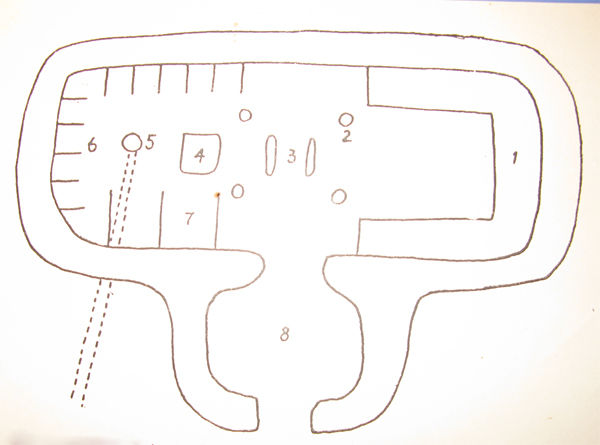The first people arrived along Nordkyn’s coasts shortly after the ice melted, 10-13000 years ago. Rich fishing grounds and an abundance of seals, whales, reindeer and other game made them settle. They represent the first stage of cultural history in Norway, the Middle Stone Age or the Mesolithic. The oldest traces of human settlements are found right north and south of the village Gamvik. These remains were earlier seen as parts of the so-called “Komsa Culture”, but this label has been left by modern archaeology. From the Neolithic period, foundations and tools have been found, and from the iron- and middle ages (ca. 500 - 1500 A.D), both graves and settlements have been discovered.
The illustration shows the plan of the traditional turf hut known as «gamme», which has been used as a dwelling for both people and livestock from Mesolithic times until after WWII. The construction was usually made of driftwood. Walls and ceiling were made of turf from the moors. The simple building technique and the cheap materials assured the “gamme” popularity among both Sami and Norwegians. The illustration shows a "gamme" were livestock and pople lived together, the animals staying to the left of the fireplace, the people to the right.
They lived in every cove
During the 14th century, the Norwegian settling of Finnmark intensified. An important reason was the dietary prescriptions of the Catholic and Orthodox churches. The banning of meat during many of the religious festivals created a huge market for stockfish. With long durability and low weight, this nutritious product was traded all over the known world by the influential Hanseatic League. Rich fisheries and ideal drying conditions thus lead to more permanent fishing villages in Finnmark. Gamvik and Omgang are mentioned in tax lists as early as 1520. After the reformation in 1536, the stockfish lost some of its earlier standing, and the coastal communities of Finnmark suffered recession. Nevertheless, little by little, people were living all along the coast wherever a boat could be dragged ashore and some grazing land for livestock could be found. The Norwegians gradually spread along the fiords, and came to dominate areas that were used by the sea Sami. However, this process has been less intense along the Tana fiord than in other fiord districts of Finnmark. During the 19th century, the villages Mehamn, Gamvik and Finnkongkeila experienced ever larger numbers of immigrants, whereas Omgang stagnated. Today, the population is concentrated in the villages Mehamn, Gamvik and Skjånes, and in a few hamlets along the Tana fiord. As the fleet is motorized, pople are not as dependant as before on living nearby the fishing grounds. Many small settlements were never inhabited again after the burnings of World War II. Better communications and bigger fish factories has accelerated centralization.



